Peter MALONE
Saturday, 09 October 2021 13:02
Novitiate, The

NOVITIATE
US, 2017, 123 minutes, Colour.
Margaret Qualley, Melissa Leo, Julianne Nicholson, Dianna Agron, Rebecca Dayan, Leona Liberato, Denis O' Hare.
Directed by Maggie Betts.
In some ways it is a surprise to find this film made and released in the 2010s. It is in the tradition of films of the past about nuns and convents but it reflects the changes in the latter part of the 20th century, after the Second Vatican Council, and the decline in numbers joining religious orders.
In the past, many actresses were eager to have the opportunity to play a nun in a film. There were some serious roles. There were pastoral roles. There were some comedies. In the 1960s, changes were indicated by The Trouble with Angels and Where Angels Go… Trouble Follows. Dead Man Walking was an impressive picture of nuns and pastoral ministry.
But the main serious film about convent life was the 1959 The Nun’s Story, released just after Pope John XXIII announced preparations for the Council. It showed what pre-Council convent life was like, the strengths, the discipline, the numbers, and the challenges which led to Sister Luke (Audrey Hepburn perfect in the role) leaving the convent.
This film is set in the first half of the 1960s (the same period as for Doubt with Meryl Streep). The setting is Tennessee, a large convent, traditional in its look and in its way of life. The superior is played with her usual strength by Melissa Leo, with self-assurance covering some self-doubt as she rules the community with some severity. The local Archbishop, Denis O’ Hare, communicates the decisions of the Council, not acceptable to the superior, and his eventually threatening her if she does not implement the changes, with dismissal.
However, the central character is the young woman, played with intensity by Margaret Qualley, who was educated by the sisters, decides to join them, experiences the detail of the formation program of postulancy and the novitiate. There is an emphasis on the Chapter of Faults, a practice for confessing one’s faults and receiving a penance – some severe from the superior. But, she is young, has had a somewhat enclosed life, little sexual awakening – and this happens and leads to an encounter with one of the sisters. It becomes symbolic of her moving to adult life and the issue of her commitment.
Julianne Nicholson plays her mother, one without faith, but who wants her daughter to make her own personal choices. The film is the directing debut of writer, Maggie Betts.
1. Audience interest in the Catholic Church? Communities of nuns? Convent formation and life?
2. The experience of the Second Vatican Council? The 1960s? Changes in the Catholic Church? The impact of the Council? In the US, with the conservative church?
3. The title, the community, the novices in formation, the role of Superior, her expectations, style, spirituality, the spirituality of the order?
4. Tennessee, the convent, the building, exteriors, interiors, rooms, common rooms, the chapel? The musical score?
5. Cathleen’s story? Her mother, not having any faith, but taking Cathleen to a church for her own decisions? Her father, his drinking, leaving? Norah, her life, the one-night stands?
6. Cathleen at school, the encounter with the nuns, the offering of the scholarship, her good grades? Enjoying school? The nuns and the talk of vocation? At age 17, the influence, her decisions?
7. The Sisters of The beloved Rose? The 20 going into the postulancy, the way of life, the details, progress? Towards the novitiate? Mother Marie St- Claire? Her presence, her personality, the program for the formation, her discipline, cold manner, traditional beliefs and practices? The using of the Chapter of Faults, the confessions, stern penances, disciplined? The effect on the young women?
8. Sister Grace, in charge of the postulants, kind, disagreeing with the superior, openness? The girls enclosed, the giggling periods? Lack of maturity?
9. Cathleen, the effect of formation on her, separating herself, reading the Bible?
10. The Archbishop, his letters about the Vatican Council, the reaction of the superior? Her disagreeing, not putting the injunctions into practice, Grace and her urging the Superior to change?
11. Cathleen, the impact of her novitiate, the seclusion, her age, lack of sexual awareness, the changes, her fears, not eating, trying to be rid of impure thoughts?
12. Norah, her visit, her husband’s death, her worry about Cathleen, the clash with the superior? The superior saying that she was Cathleen’s mother because of her commitment to the church?
13. Cathleen, the collapse, in the infirmary, the sexual experience at night, the visit to the room of Sister Emanuel, the sexual encounter and its effect?
14. The Archbishop, the confrontation with the superior, his threat to dismiss her?
15. The effect on the superior, on her faith, of her sense of herself, of her place in the church?
16. The Chapter of Faults, Cathleen confessing, not naming the nun? The penance, on her hands and knees? Sister Emanuel leaving?
17. The council changes? Mass in English? Priests facing the congregation? Equality with the laity? The nuns and habits and what they would wear? The consequences?
18. The numbers leaving the novitiate, the small group for profession? Their commitment and language? Cathleen and her wanting something more?
Published in Movie Reviews
Published in
Movie Reviews
Saturday, 09 October 2021 13:02
Light of Western Stars, The/ 1930
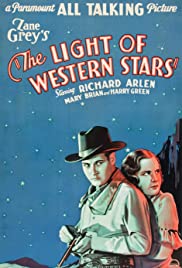
THE OF LIGHT OF WESTERN STARS
US, 1930, 70 minutes, Black-and-white.
Richard Arlen, Mary Brian, Harry Green, Regis Toomey, Fred Kohler, Guy Oliver.
Directed by Edwin H. Knopf, Otto Brower.
This is an action Western based on a Zane Grey story which had been filmed as early as 1918.
The locations are familiar, a saloon, initially, and a brawl; a homestead on a farm; work on the farm; and a brawl in the homestead.
Popular star, Richard Arlen, plays Dick, seen initially with his friend Pie- Pan (Harry Green), on something of a bender in the saloon, Dick is upset at the death of his friend Jimmy Hammond. Dick also declares will marry the first woman he sets eyes on – which happens to be Ruth Hammond, arriving from the East to claim her brother’s farm.
Next day Dick and his friends seek work and apply to Ruth who, remembering the first encounter, sends him off. Later, Ruth’s admirer from the East (Regis Toomey) comes to complicate matters.
Enter the villain, Stack (Fred Kohler) who had killed Jimmy Hammond, claims he had paid back taxes on the farm, confronts Ruth, stating that the farm is his and that she should leave. There is a further complication that he is in league with the crooked sheriff who backs up his claims.
Which, in the Western tradition, leads to a confrontation, extensive fisticuffs, gunfire, the defeat of the villain, the exposure of the sheriff, and a romantic ending.
A small entertaining Western of its times.
Published in Movie Reviews
Published in
Movie Reviews
Saturday, 09 October 2021 13:02
License to Kill/ 1984
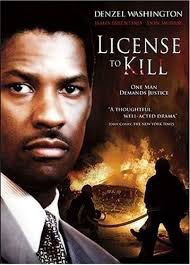
LICENSE TO KILL__
US, 1984, 96 minutes, Colour.
James Farantino, Penny Fuller, Don Murray, Millie Perkins, Denzel Washington, Ari Meyers, Donald Moffat, Jacqueline Brookes, Kristin Vigard.
Directed by Jud Taylor.
License to kill sounds like espionage and, in fact, within four years the James Bond film of this title was released. Audiences may think at the beginning of this film that it will be a revenge film, the father taking revenge for the drunk driving death of his daughter.
This is a television film of the 1980s and made an impact with its message about drink-driving and the consequences. Later commentators have found the message too obvious – but, the average television-watching audience will probably find it effectively hard-hitting.
The film shows the ideal American family, the young daughter getting a school prize and about to go off to college, killed in the drunk driver accident. Her parents are played by James Farentino and Penny Fuller, the father having the male reaction, wanting to be busy rather than at home supporting his wife and expressing his emotions. The wife, not supported by her husband, withdraws. (One hopes that with growing consciousness since the 1980s, there is much more effectiveness in husbands and wives supporting each other.)
There are delays in the court hearings. The driver is played by Don Murray, in denial about his drinking and concerned about his reputation. His supportive wife is played by Millie Perkins who is aware of his drinking.
In the court, Jacqueline Brookes is an effective judge, strong in her final summing up in sentencing. Donald Moffat is the shrewd lawyer for the defence. Denzel Washington in an early role is the prosecutor.
1. The title? Not an espionage story? Drunk driving and the license to kill on the roads?
2. A film of the 1980s, the television audience, television style in drawing characters, issues, message film? Its impact now?
3. The ordinary American city, the ordinary American family, college, socials? The atmosphere of the prize-giving? The family at home, family pride? The two sisters? The boyfriend, the social? The sleepover?
4. Lynn, her character, success, her parents, offering to drive her sister, watching the people of the town, the crash, her injuries, dying in hospital? The news for her parents, the phone call, going to the hospital?
5. Her father’s reaction, going out of the house, not dealing with the death emotionally, the male busy reaction? The contrast with her mother, going into herself, no support from her husband, her withdrawing into her room, to bed? The father telling the little daughter, the denial, upset, yet managing the house despite her mother, the meals?
6. Fiske, with his pals at the club, on his building sites, his drinking, jovial, nobody stopping him driving? Driving drinking, smoking, not paying attention, swerving with the boy on the bike the boy’s falling? Not giving way that the stop sign? The crash? His minimal injuries? Asking about the ambulance? Going to phone his wife? Asking her to pick him up? The police and their reaction, the witnesses, the smell of alcohol? His asserting himself? Being taken by the police? The blood alcohol test? His going home? His wife and her concern about his drinking? His later continuing, denial of the previous arrests, drunk and taking the boys to the match, his wife’s protest?
7. Jack and the discussion with the lawyer, the grief of the funeral, Jack leaving, returning late, abandoning Judy? The discussion about civil and criminal cases? His not wanting money? His growing obsession with justice? The appointment from the district attorney, the busyness of the office, the offhand manner of the receptionist, phone calls not returned?
8. The increasing tension at home, his insensitivity to Judy, her eventually giving up, the possibilities for talking, possibilities for reconciliation? The daughter, her being upset, not wanting the sleepover? Her father busy, studying the books? His not performing well at work and the loss of custom?
9. Going to court, the encounter with Martin Sawyer? His being overburdened with cases? Not personal enough with Jack? The continuance for one month, then the later continuance, the judge, presence, attention to the case, her demanding that they be ready?
10. Fiske, the discussions with the lawyer, his reputation, getting the accused of from drink driving cases, his fee? Discussions? The tactics? Shrewdness? Availability of witnesses? His cross-examination? The boy and his falling from his bike? The neighbour and hearing five words and asked whether he was a linguist? Cross-examination of the policeman, the emergency, the blood sample on the desk for hours, grounds for not admitting the results?
11. The discussion with Fiske and his wife with the lawyer, the issue of whether he would testify on not? His wife’s point of view? The lawyer’s point of view? Fisk going on the stand, the evidence against him? Sawyer, the witness of the credit card, the bills at the restaurant and club, proving that he had more to drink?
12. Jack, Judy going with him to the case? The impact of the hearing? The judgement of the jury? Sawyer’s appeal for imprisonment? The judge and her speech against drivers? Jack leaving, weaving?
13. Judy, the encounter with Mrs Fiske, their wishing well to each other?
14. The relevance of this kind of story, always? The moralising – and the appeal to ordinary citizens, television movie watchers?
Published in Movie Reviews
Published in
Movie Reviews
Saturday, 09 October 2021 13:02
Crimines de Familia/ The Crimes that Bind
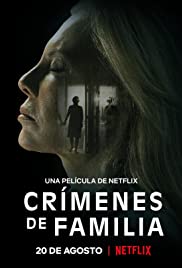
CRIMINES DE FAMILIA/ THE CRIMES THAT BIND.
Celia Roth, Miguel Angel Sola, Benjamin Amedeo, Yanina Avila, Paola Barrientos, Sofia Gala Castiglioine.
Directed by Sebastian Schindel.
The Spanish-language title focuses on the crimes of the family, family ties – and ties that bind. However, for the most part, the crimes actually force members of the family apart. But, surprisingly by the end, there is some binding and reconciliation for some.
At the centre of the film is the mother of the family, Alicia, Spanish actress in Almodovar films, Cecilia Roth. The audience first sees her at aerobics, with her affluent friends. She is not a sympathetic character, arrogant in her manner, yet very tender in her looking after the little boy, the son of the maid, Gladys, a woman who is reserved and does not speak much. The film is very much a focus on Alicia, her devotion to her son whom she had spoilt, wanting to get him out of prison at any cost, hostile towards his wife and her testifying against him.
In terms of crimes, there are two major crimes, and two court cases, a lot of time spent in the courts, the role of the judges in Argentina, defence counsel, the attorney for the prosecution who has the opportunity to ask most of the questions of witnesses as well is the accused.
The first court case is that of Alicia’s son Daniel, who gives an impassioned account of himself, quite emotional, justifying all that has been done to him, his failure in business, his continued need for money, dependence on his family, his marrying his wife, the birth of their child, his drug dependence, his suspicions of his wife’s behaviour. Later in the trial, his wife has the opportunity to give her side of the story, quite impassioned, and quite different from that of her husband.
The second court case is that of Gladys, accused of murder of a relative – the audience has seen the corridor in the house, the closed door to the bathroom, the sight of blood, a mop, but is not sure what has happened. Gladys is inarticulate, reticent, but, ultimately, linking the two cases as to the behaviour of Alicia’s son and his stealing money and his sexual assault on Gladys.
Alicia wants a lawyer who will pay bribes to get her son out of jail, even selling the house, and alienating her husband who leaves. She succeeds with her son – only to find out the truth, a transforming experience, the realisation that she has two grandsons and her taking steps towards reconciliation.
In fact, a lot happens and 99 minutes – and it takes time afterwards to absorb Alicia’s experience and her change.
1. The title? Family ties, family crimes, ties that bind?
2. The Argentinian setting, Buenos Aires, homes, streets, offices, the courts? The musical score?
3. The opening, the closed-door, the shadow, opening the door, the repetition of this sequence? The audience wondering? Seeing Gladys? The blood? The final revelation?
4. The credits sequence, the camera roaming through the room, the range of photos, religious statues, the emphasis on family?
5. The focus on crimes? The focus on the family? The two court cases?
6. Introduction to Alicia, the aerobics class, chatting with her friends, high society? The later meeting with her husband? A retired engineer? Their son, Daniel? His phoning from the prison? Their going to see him at the prison, his mother concerned, his father formal?
7. Daniel in court, his opportunity to make his speech, the detailed self-justification, the audience believing him or not? His story, education, comfortable, business, the business failure, the need for money, meeting his wife, the birth of the son, his drug dependence, her working, his accusations about her behaviour, the alleged physical assault? Audience empathy or not?
8. His mother and her concern? Wanting to employ the lawyer, her husband’s resistance, his explanation of the high cost of money for bribes? His exasperation, with his wife’s moods and staying at home, his decision to leave? The selling of the house?
9. The second trial, Gladys? The scenes of her working at home, taciturn, with the baby? The audience discovering that child was hers? His calling Alicia auntie? Alicia’s devotion to the child, play, cooking, cartoons, picking him up from school, visits?
10. Gladys, waking up in hospital, the handcuffs, taken to prison? The interview with the lawyer, his secretary and getting the information, the information for the audience? Her unwillingness to answer questions?
11. The psychologist, interviewing her in the prison, getting some answers? The nature of the charge – but the audience not knowing the detail?
12. Alicia and her husband, the presence of both trials? Eventually her husband absent from Daniel’s trial?
13. The role of the judges in Argentinian courts? Presiding, questions? Their interventions? The importance of the defence counsel? The significance of the attorney, his privilege in asking all the more detailed questions?
14. Daniel and his interrogation, his self-justification? His wife, her long speech, the different interpretation of the events? The credibility?
15. Alicia visiting the lawyer, the expenses, the money for bribes? The decision to sell the house, packing up, her husband’s reaction? Leaving? Daniel returning home, eating the meal, proposing to borrow money from his mother?
16. Gladys, the interrogation, the simple speeches, the thanking Alicia and nominating her as guardian for her son?
17. Alicia, under interrogation, her antagonism towards the defence lawyer?
18. The judges, Gladys and the sentence? The possibility for an appeal?
19. Alicia talking to Gladys, the issue of the money stolen, Gladys revealing that it was Daniel, and his sexual assault? The impact on Alicia, that the boy was her grandson?
20. Alicia, her hostility towards Daniel’s wife, her change of heart? The issue of the semen and the DNA, a proof of Daniel’s attacking his wife? Alicia getting the document, going to visit the wife, giving her the document?
21. The visit to the prison, Gladys playing with the little boy? The appeal?
22. The crimes of the family tearing the family apart? Alicia taking her grandson to meet her other grandson, preparing the birthday cake, the hope and reconciliation?
Published in Movie Reviews
Published in
Movie Reviews
Saturday, 09 October 2021 13:02
Pimpernell Smith
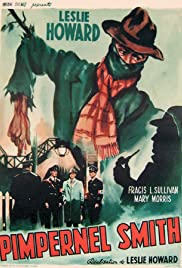
PIMPERNEL SMITH
UK, 1941, 120 minutes, Black-and-white.
Leslie Howard, Francis L.Sullivan, Mary Morris, Hugh Mc Dermott, David Tomlinson, Raymond Huntley, A.E.Matthews.
Directed by Leslie Howard.
Leslie Howard appeared as The Scarlet Pimpernel of the classic adventure of 1934. Here he plays a World War II variation on the character and theme. (Gregory Peck was to play another World War II variation in The Scarlet and the Black, an Irish Vatican official saving Jews.)
This is an entertaining war propaganda film, important in its time, especially a final prophetic speech given by Leslie Howard looking straight to camera. Howard was not to see the end of the war because he was killed in a plane crash in 1943.
He plays a Cambridge Professor of archaeology, seemingly absent-minded, anti-women. He takes a group of his students to Germany with him, effecting the rescue of prisoners in concentration camps (hiding as a scarecrow in the fields and wounded when the commanding officer shoots at the scarecrow). The students see the bleeding, read the papers and draw their conclusions, very surprised at the change of perspective on the Professor.
The final action takes place in Berlin, at an archaeology site, with an invitation to a reception at the British Embassy, dismissed as a possible spy by the head of the Gestapo (an interesting performance by Frances L.Sullivan who believes that Shakespeare was German!), But under suspicion by a German agent who is later revealed as the daughter of a Polish newspaper editor who has been interned and she has been commissioned to find out who effected his escape. She has an intuition that it is the Professor. She is played by Mary Morris.
There is some tension between the two, the Professor investigating her, finding she is genuine, promising to rescue her father – which happens in a quite spectacular way, with the Professor, first of all, posing as an arrogant American journalist and dominating the Gestapo office, going with his students as journalist to have a tour of the concentration camp, overcoming the officials and their all escaping. The Professor, however, returns to Berlin to rescue the daughter – and, despite his commitment to the statue of Venus that he discovered and his infatuation with the statue, his falling in love.
There is a dramatic escape from Berlin, a train journey, the Polish border, the Gestapo head confronting the Professor but, as was the Scarlet Pimpernel whom they had been seeking everywhere, he is elusive and escapes.
This is a film that Howard made immediately after his role as Ashley Wilkes in Gone with the Wind. He also directed the film.
1. World War II propaganda film? Impact in its time? Interest in its historical role? As an entertainment?
2. Leslie Howard, director, star, his reputation, screen presence, particular delivery? His role as The Scarlet Pimpernel and its memories?
3. The settings, Berlin and smuggling prisoners, the Cambridge settings and the University, the travel to Germany, to Switzerland, the concentration camps, the Berlin reception, the Gestapo officers, the trains, the excavations, the Swiss and Polish borders? The musical score? Blue Danube, There is a Tavern in the town…?
4. The initial mission, the scientist and the guinea pigs, his friends, the newspaper editor – Freedom? The work of Pimpernel Smith? The shadow on the wall? The Gestapo, the pursuit, the arrest of the editor? His being interned? Not giving information about the rescue?
5. Horatio Smith, the long sequence of his admiring the statue of Aphrodite, the school teacher and the children? His absentmindedness? The comments of the students? The dice? Pocketing it? His denouncing of the women – and their leaving the classroom? His inviting the young men to accompany him to the continent? The volunteers, Maxwell and his change of mind? His capacity for organisation?
6. The journey, the camaraderie, Smith and his seeming lackadaisical approach, the drinking, the hotels, timetables, trains?
7. The mission, the men working in the fields, the brutal overseer, the scarecrow, the wounding of his arm? The escape? The newspaper reports? Smith and his arm bleeding? The reaction of the young men? His confiding in them?
8. The excavations, contact with the University? The search for an Aryan civilisation?
9. The German authorities, General Von Graum, the reports about the escape, his underlings, Marx, the general and the Gestapo, his size, eating the chocolates? Suspicions?
10. The reception at the British Embassy, the British authorities, the guests, the tearing of the invitation with the time on it, Smith and his nonchalant presence, the invitation, tearing the other invitations, putting them in Marx’s pocket, his conversation with Von Graum, Shakespeare as a German, the quotation from Romeo and Juliet, Von Graum and the discussion about the British sense of humour and its lack, the examples, his not seeing the joke, the quotation from Lewis Carroll, and Smith later talking with Von Graum and bringing him the book? Von Gruam suspicious of the man who said “absolutely nothing�? Dismissing the professor?
11. The presence of Ludmila, the editor’s daughter, in the US, the return to Germany, her father in prison, her being asked to spy, at the reception, suspicious, her intuition about the professor, Maxwell and his intruding, getting information from him? Going to the bar, her talking with the professor, his reactions, her later visiting his room, the purse, the powder? The spies following her?
12. The lunch, the professor buying the powder from the French shop, his getting someone to check on her identity, verified? His sympathy, his promise?
13. Von Graum, his suspicions, letting them go free? The information about the transfer of the editor, knowing that his daughter had seen the information? The setup?
14. The elaborate organisation of the escape, the other journalists? The false phone calls? Smith and his elaborate make up, his manner, barging in and taking control, manipulating
the officials, getting the permits, the umbrella, the muddy shoes and his authoritarian manner? The drive to the camp, the young men as American journalists, the tour?
15. The escape, their being held under ground, with the artefacts from the excavation?
16. The professor, turning up, Von Graum and the discussions about Lewis Carroll? His letting them go?
17. The packing of the artefacts, Von Graum’s men coming to examine the artefacts? The train journey, the plane, supervising the boxes, the professor asleep, his substitute, at the border, everybody getting through? The examination of the artefacts?
18. Ludmila, anxiety, interrogated, Smith’s return, the escape, the fire escape, getting to the station, in the carriage? At the border? Ludmila let through? Von Graum and his confrontation with Smith, the importance of Leslie Howard speaking the prophetic words, straight to camera, about the future of Nazism and its defeat?
19. The plan for Smith to try to cross the border and be shot? The distraction – and his disappearance?
20. An old-fashioned British adventure story? Hero? Heroics? And the propaganda for World War II?
Published in Movie Reviews
Published in
Movie Reviews
Saturday, 09 October 2021 13:02
Golden Exits

GOLDEN EXITS
US, 2017, 92 minutes, Colour.
Emily Browning, Adam Horowitz, Mary- Louise Parker, Chloe Sevigny, Jason Schwartzman, Analeigh Tipton, Lily Rabe, Craig Butta.
Directed by Alex Ross Perry.
This is a film for audiences who enjoyed New York characters and their interactions. In some ways it is a miniature kind of film, and a great deal of dialogue.
The focus is a young Australian, Naomi, played by Emily Browning, who is visiting New York, as an interview for a job helping an archivist, gets the job, meets the arc of his family, his wife and his sister in law), makes contact with the son of a friend of her mother and meets up with him.
The archivist is played by Adam Horowitz (from the Beastie Boys, son of Israel Horowitz). His wife is played by Chloe Sevigny. His rather independent-minded sister-in-law is played by Mary-Louise? Parker. She has a friend, Sam, played by Lily Ray. The son of her mother’s friend is Jason Schwartzman who is married to Annalee Tipton.
Naomi does her work, enjoys meeting the archivist’s family, as well as the friend. The action takes place over only two months, with various dates in April and May coming up on screen. Naomi does her work. The archivist is intrigued by her but she puts him off. She discusses his relationship with his wife with the friend who is also attracted to her.
She leaves to go home to study in Sydney, asking a reference from the archivist, leaving the others to sort out the relationships.
1. Title? Rivals? Leaving? The significance of golden?
2. A New York City film, the locations, streets, homes, offices, restaurants? The musical score?
3. The intersection of families? Love, tensions, breakups? Crises?
4. Naomi, her Australian background, her age, arriving in New York City, her hopes? Meeting Nick, Alyssa? The interview for the job? Arranging archives? Her making a good impression? Her accommodation and apartment? The going to work, her skills? Nick taking her to lunch? Lunch and her salary? The meeting with Gwen, the discussions, Gwen’s explanations, challenges? Meeting Buddy, his mother her mother’s friend? Sense of duty? The conversations?
5. The range of dates, from April to June? Naomi’s experience in the United States?
6. Nick, his age, background, the marriage to Alyssa, Alyssa and her psychology work, clients? The tensions, suspicions about Nick? Nick, going to the birthday party, the drinks, the camaraderie? Meeting Naomi, his approach, her resistance? The perfume, Alyssa smelling it, suspicions?
7. The meeting with Buddy, the conversations, the attraction? Her inquiring about Jess?
8. Buddy and Jess? Their sound recording business, their working together, the marriage? Jess and her friends? Buddy and his friends? Clients and interviews? The final conversation together?
9. Gwen, independent spirit, friendship with Sam? Sam and her personality, the conversations? The meetings with Naomi? The parting from Gwen?
10. Naomi, finishing her time in New York, asking for a recommendation by Nick, his saying her work was satisfactory? Her going to study in Sydney?
11. Nick and Alyssa talking together? Reconciliation? Hope for the future?
Published in Movie Reviews
Published in
Movie Reviews
Saturday, 09 October 2021 13:02
Vai

VAI
New Zealand, 2019, 90 minutes, Colour.
Directed by:
Nicole Whippy
‘Ofa Ki -Levuka Guttenbeil- Likiliki
Matasila Freshwater
Amberley Jo Aumua
MÄ«ria George
Marina Alofagia Mc Cartney
Dianna Fuemana
Becs Arahanga
Produced by:
Kerry Warkia
Kiel Mc Naughton
Screenplay by:
Sharon Whippy
Nicole Whippy
‘Ofa- Ki- Levuka Guttenbeil- Likiliki
Matasila Freshwater
Amberley Jo Aumua
MÄ«ria George
Marina Alofagia Mc Cartney
Dianna Fuemana
Becs Arahanga
Cast:
Hinetu Dell
Maliaga Erick
Fiona Collins
Evotia-Rose? Araiti
Agnes Pele
Betsy Luitolo
'Ar- Ramadi Longopoa
Mereani Tuimatanisiga
Vai is an arresting film from and about the Pacific. There is a central character, Vai, and a continuity of story – except that it moves from country to country, different stages of the story of Vai, adapted to the culture of the particular location where the action takes place.
From the website of the New Zealand Film Commission:
The film offers an opportunity to see and appreciate the look of each location, the portraits of people, the re-enactment of events, the female journey in its various ages and stages.
Vai is a portmanteau feature film made by nine female Pacific filmmakers, filmed in seven different Pacific countries: Fiji, Tonga, Solomon Islands, Kuki Airani (Cook Islands), Samoa, Niue and Aotearoa (New Zealand). It is about the journey of Vai, played by a different indigenous actress in each of the Pacific countries. In each of these Pacific nations ‘vai’ means water.
Fiji: In a modest dwelling in Fiji a 7 year-old girl with boundless energy tries to understand why she has to say goodbye to her home country and extended family as her mother prepares her to leave Fiji.
Tonga: Vai, now 13, dreams of going to NZ to sing but her day-to-day chore of filling up water bottles from the neighbourhood water tanks makes her feel as though she will never leave Tonga.
Solomon Islands: While fishing from a small canoe off the coast of the Solomon Islands, 16 year old Vae argues with her mother about the correct way to bait the fishing hook.
New Zealand Born Samoan: Having worked hard to get into university, 21 year old Vai is now a top student, and one of only two pacific islanders in her class but with her attendance waning due to pressures at home, she finds it difficult to get support from her tutor and struggles to find her voice in a system that isn’t built for her.
Kuki Airani (Cook Islands): Amidst apathy, fear and the trappings of colonialism Vai makes a stand for change on her island of Rarotonga, finding her voice as an activist.
Samoa: In her 40s now, Vai returns to Samoa to perform for an important event but, having been away for many years, Vai struggles with her connection to the performance.
Niue: Vai, now 64, tries to convince her granddaughter, Moana, that leaving the island of Niue will give her an equal start in life.
Aotearoa: An elderly Vai, 80 years old, gathers with her wh�nau (family) by the river’s edge to perform a naming ceremony for her great granddaughter, Vai.
Published in Movie Reviews
Published in
Movie Reviews
Saturday, 09 October 2021 13:02
Four Just Men, The
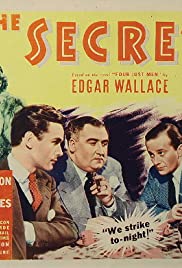
THE FOUR JUST MEN
1939, 85 minutes, Black-and-white.
Hugh Sinclair, Griffith Jones, Francis L.Sullivan, Frank Lawton, Anna Lee, Alan Napier, Basil Sydney, Lydia Sherwood, Edward Chapman.
Directed by Walter Forde.
The Four Just Men are veterans of World War I, patriots, who combine their skills, and together to investigate crimes and bring criminals to justice. They are a secret for.
The film is based on a 1905 novel by Edgar Wallace, updated to 1938. It has a tense opening with two men about to be executed by the Nazis in Regensburg and one of them rescued by a German officer – one of the Four impersonating the officer. The audience is introduced to the four, a leader who has a capacity for impersonation, the man who was rescued from prison and has a terminal health condition, a French patriot who has the cover of a fashionable dress business, the other a playwright.
The situation they are investigating concerns the leaking of information by parliamentarian – in fact, through his wife’s, to a contact played by Basil Sydney, who kills her. She is able to be identified by an eager journalist, played enthusiastically by Anna Lee, who has also met some of the Just Men unknowingly. Part of the plot is for a traitor parliamentarian to make a speech, urging against rearmament. However, the Just Men intercept him, killing him, and the leader with talent for impersonation made up and going into the parliament and retracting the anti-rearmament stands.
It is interesting to Francis L.Sullivan having a central role and being far more sympathetic than in his usual roles. Griffith Jones is the suave member of the Four.
1. Political thriller? The context of 1938? Nazis? British stances, peace, appeasement, rearmament?
2. Based on an Edgar Wallace story, written in 1905, updated? The interest in espionage? The interested in journalism and newspapers?
3. The London setting, the details of the city, homes, offices, railway stations? The streets? The parliament? The musical score?
4. The tone of the opening, the executions in Regensburg, 1938, the picture of German severity, the two men in prison, tapping for information, the Commandant, demanding, the execution? The arrival of the authority, Terry being saved? Hampshire impersonating the officer, the escape, the meal? The information?
5. The title of the film, the action in World War I, the British, the French contribution? The introduction, their personalities, their covers? The Frenchman and his fashion shop? Brodie and his theatre writing? Terry and his travels, given six months to live? Hampshire, his ability to impersonate people?
6. The information about their cases, achieving justice, their methods, secrecy, the use of violence, even death?
7. Newspaper background, women journalists, Ann, her eagerness, the attitude of the editor? Information about the Four Just Men, the reporter and his insisting they were Russian? His mission, not finding out anything?
8. Ann going to the fashion show, encountering the Leon, meeting Brodie? The clothes, the perfume? Myra Hastings and the fur? The next day, encountering the men in the car? Seeing Myra Hastings? On the reporter’s job, getting the information, phoning through the story?
9. The Just Men, Terry abroad, his phone call with the information, the line being cut, his returning to England, the encounter with Frank Snell and the suitcase, the poison, his going to the apartment, the encounter with Ann? The map? Shooting Snell? His death?
10. Brodie, following Myra Hastings, her visit with Snell, the documents, her fears, his pushing her down the lift shaft? The police, Ann identifying Myra Hastings because of the fur and perfume?
11. Leon going to the rally, Sir Hamar Ryman and his speech, Frank Snell present, wanting to warn, the note, bring it to the stage, the pickpocket and Leon, his giving him the money to steal the note and return it? The rendezvous address?
12. The foreign power, the traitors, seeking the note and the Suez Canal, blowing up oil fields, bringing down the Empire?
13. Ann, her being locked in the cupboard by Brodie? The sparring and yet the attraction?
14. Sir Hamar Ryman, meticulous, his bath, timetable? The expose in the papers about the Four Just Men? His decision to go to the parliament? Humphrey, his impersonations, the killing of Ryman, his make-up, the speech in the parliament, the confirmation of his information?
15. The ending, the presentation of Hitler and the Nazis, the opening of World War II – and the added ending for the US, to get their support for the war?
Published in Movie Reviews
Published in
Movie Reviews
Saturday, 09 October 2021 13:02
Captain Scarface
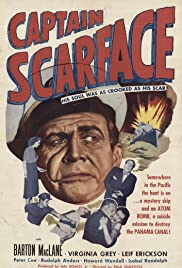
CAPTAIN SCARFACE
US, 1953, 72 minutes, Black-and-white.
Barton Mac Lane, Virginia Grey, Leif Erikson, Peter Coe, Rudolph Anders, Paul Brinegar.
Directed by Paul Guilfoyle.
A minor, B-budget supporting feature of the early 1950s. There is an atmosphere of the Cold War about the plot, an attempt to blow up the Panama Canal by Communist activists.
Barton Mac Lane is the captain of the ship, Communist sympathiser, dominating his crew, with a great deal of equipment for the detonation of the bomb (not really explained how it got onto the ship, especially as the captain’s original ship is shown initially as exploding and his new ship made to resemble the destroyed ship). He is not keen on passengers coming aboard. However, three American tourists are to return to the US, and a scientist and his daughter are also to be on board. A local American property supervisor is getting out of the country after tangling with the wife of his employer.
The early part of the film establishes the captain and his crew. It also introduces the passengers at a local hotel – but, a mysterious man accompanying a scientist and meeting up with his daughter tangles with one of the crew of the destroyed ship who demands his payment. They are all part of the plan to get the scientist on board so that he can destroy the canal, his daughter being held as a hostage.
However, the supervisor, Leif Erickson in an early role, turns out to be not only the hero but the romantic hero. A lot of double-dealings, threats to the scientist, threats to his daughter, the tourist wife dying and her grief-stricken husband throwing himself over board.
Not particularly plausible at all, but time-filler indicating Communist fears of the 1950s.
Published in Movie Reviews
Published in
Movie Reviews
Saturday, 09 October 2021 13:02
Gary of the Pacific
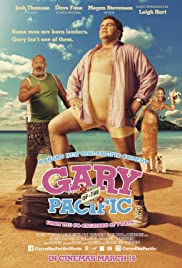
GARY OF THE PACIFIC
New Zealand, 2017, 85 minutes, Colour.
Josh Thomson, Megan Stevenson, Matt Whelan, David Fane, Taofi Mose- Tuiloma, Dominic Ona Ariki.
Directed by Jarrold Holt, Ryan Hutchings.
This is an intentionally lowbrow comedy. The writers-directors describe themselves as the lowdownconcept. Many will agree that they live up to their title!
The film was made on the Cook Islands as well as in New Zealand. The initial setting is an island which is sinking. The focus is on a young boy, Gary, who embodies the hopes of the elders of the island, especially his father, the chief. Gary is sent off to New Zealand to study at the University, relying on the savings of his family and the people. He is not successful, but does not let the islanders know. Years pass and he becomes a real estate agent, not particularly successful. He has a girlfriend, Chloe (Meagan Stevenson) who is something of a social climber.
Gary is played by popular comedian, Josh Thomson, not afraid to send himself up. The chief of the island is played by another comedian, David Fane.
Gary goes back to the island as his father is dying. He is nominated the chief and the small community agree. While his father dies, he is a visual presence for Gary throughout the rest of the film. Gary may have good intentions (open to question) and Chloe is ambitious for a lavish wedding. Island funds are to be steered towards that wedding. This means the postponing of his sister’s wedding to a New Zealander who lives on the island. Eventually, matters get sorted out – sometimes more, sometimes less.
There are quite a number of gross sequences and images that reinforce thelowdown concept treatment.
Some moderate reviews from New Zealand – but a number of not very complimentary reviews, critical of the lowdown humour.
Published in Movie Reviews
Published in
Movie Reviews